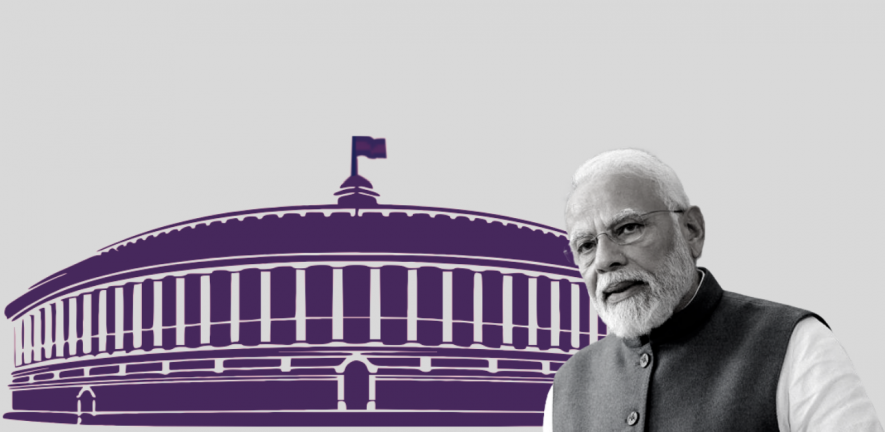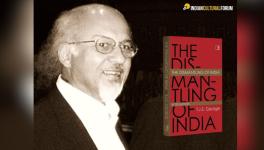Vishwakarma Yojana is Varnashrama Dharma in New Bottle

The PM Vishwakarma Yojana mirrors past caste-based exclusionary policies, confining marginalised groups to traditional occupations and impeding their access to higher education, contradicting constitutional principles of justice and equity.
—-
“The food is grown, the cloth is woven, the sheep are shorn, the shoes are stitched, the scavenging is done, the cartwheels and the ploughs are built and repaired because, thank God, the respective castes are still there and the homes are trade schools as well and the parents are masters as well, to whom the children are automatically apprenticed.” — C. Rajagopalachari
The Prime Minister of India recently announced the PM Vishwakarma Yojana, a scheme purported to benefit traditional artisans and craftspeople.
The Union cabinet has given its approval for this whopping ₹13,000 crore scheme which is to be jointly implemented by the Ministry of Micro Small and Medium Enterprises, the Ministry of Skill Development and Entrepreneurship and the Department of Financial Services, Ministry of Finance.
The alleged main objective of the scheme is to recognise traditional artisans and craftsmen as ‘Vishwakarma’ and uplift their skills and products by providing subsidised loans, skill training and monetary incentives.
The Vishwakarma scheme sanctifies the birth sanctioned occupations ordained by caste.
However, the Dravidar Kazhagam (DK) has voiced out against this scheme, saying that the Vishwakarma scheme sanctifies the birth-sanctioned occupations ordained by the caste system.
Krishnasamy Veeramani, the president of DK, has stated that the scheme will be opposed tooth and nail in Tamil Nadu.
This has brought together the allies of the ruling Dravida Munnetra Kazhagam such as the DK, Indian National Congress, Viduthalai Chiruthaigal Katchi, Marumalarchi Dravida Munnetra Kazhagam and the Communist Party of India (Marxist) to protest against the scheme in unison.
The memories of casteist policies in Tamil Nadu
In 1952, speaking at a Washermen’s conference in Thiruvanmiyur, the then chief minister of Tamil Nadu, Thiru C. Rajagopalachari said:
“People ought to do the jobs as prescribed by their respective castes. It is not mandatory for a washerman’s child to be educated and it is more than enough if he does his hereditary occupation. If everyone is educated, how will they find suitable employment?”
The very next year, he introduced a scheme called the “Madras Scheme of Elementary Education” without consulting his own cabinet or the members of the legislative assembly.
This scheme reduced the elementary school working hours from five to three hours and divided the classes into two shifts.
This aimed at encouraging children to return to their homes after the regular classes in the first shift at school and assist their parents and learn their family occupation during the second shift.
Since the majority of the occupations in India were segregated based on caste, this scheme enabled the children of doctors, lawyers, government servants etc., predominantly belonging to the upper castes, to thrive and continue to uplift their status and livelihood.
However, it restricted the children of potters, cobblers, farmers, shoemakers, scavengers etc., who belonged to the lower castes, to continue their hereditary manual jobs without any way out.
This uneven scheme paved the way for maintaining the disproportionate status quo of caste representation in white collar vis-à-vis blue collar jobs.
This dubious scheme was vehemently opposed by Thanthai Periyar, who infamously named it as Kula Kalvi Thittam (‘Hereditary Education Policy’). He was of the opinion that this scheme reconstructed and fortified the ‘Varnashrama Dharma’ and called for statewide protests against its implementation.
The Vishwakarma scheme has paved the way for maintaining the disproportionate status quo of caste representation in white collar vis-a-vis blue collar jobs.
Tamil Nadu witnessed year-long agitations against Rajagopalachari’s scheme, led by Periyar and the nascent Dravida Munnetra Kazhagam, which at the time was the opposition party in the state legislative assembly.
Two amendments were also introduced in the assembly as a reaction to the scheme, one of which demanded that it should be scrapped. The scheme also divided the Congress legislators, a majority of whom were against its introduction.
After an embarrassing defeat in a bypoll in the Kangayam constituency and a dramatic final strategic move by Rajagopalachari, in which he stated that he will tender his resignation as the chief minister if the scheme was allowed to be implemented, this scheme had its fair share of historic moments.
Finally, in 1954, due to the cascading pressure of the state-wide agitations, the demands of the opposition, and the revolt of his own party members, the scheme was scrapped, and its architect Rajagopalachari also resigned from his post.
The explicit casteism of the PM Vishwakarma Yojana scheme
The PM Vishwakarma Yojana closely resembles Rajagopalachari’s Hereditary Educational Policy, as it indirectly encourages caste-based occupations in the guise of preserving traditional arts and crafts.
The scheme’s foundation relies on caste-based occupations rather than solely on the occupation itself, as the guidelines of the scheme classify and name the 18 “family-based traditional trades” after their respective caste names.
As per the guidelines, the benefits of this scheme are made available only to persons who are engaged in the specified “family-based traditional trades”.
The head of the gram panchayat shall specifically verify that the beneficiary has been traditionally engaged in the trade, meaning that he falls within the specific caste hierarchy and identity within a particular family.
This implies that individuals who are willing and show interest in pursuing any of the specified occupations but do not have a family background in that occupation, are not eligible for any benefits of this scheme.
For example, if a person who is born outside of the Kumhaar caste based family is interested in practising pottery, he will not be eligible to the benefits of the Vishwakarma Yojana, as he falls outside the Kumhaar family based traditional trade.
If the true aim of the scheme is to promote traditional artisans and craftspeople, the scheme should be made available to any person who is willing to practise and engage themselves in such professions.
A barrier to higher education for the marginalised Bahujan communities
According to the PM Vishwakarma Yojana, the minimum age for a beneficiary to avail the benefits of the scheme, including the loans that are available under the scheme, is 18 years.
It must be noted that 18 years is the age at which most young persons stand at the crossroads of life, trying to choose and decide their desired career path through formal university education.
It is the age at which young students run across colleges to opt for their dream courses which would take them closer to their desired positions in life.
The Vishwakarma scheme closely resembles Rajagopalachari’s Hereditary Educational Policy, as it indirectly encourages caste based occupations under the guise of preserving traditional arts and crafts.
Most traditional family-based trades mentioned in this scheme belong to the marginalised castes and communities that have historically seldom had representation in any power structures.
Instead of empowering the young members of these communities to step out of their caste-based trades and aim for white collar professions predominantly controlled by members of the upper castes, this scheme seeks to confine them to their traditional caste-based occupations, thereby perpetuating caste hierarchies.
This mirrors the mindset of Rajagopalachari, who prohibited higher education for the marginalised castes in order to maintain the status quo of Bahujans being relegated to low-paying, disrespected jobs, while upper caste individuals continue to occupy positions of power, and influence policy and decision making.
In fact, the prevalent discouragement of members of the marginalised caste groups is very apparent from the regular cases of heinous bullying, leading to suicides of bright young minds such as Rohit Vemula and Payal Tadvi.
These incidents increasingly demonstrate making academic places non-conducive for young Bahujan learners.
Amidst the upper caste distaste against constitutional provisions for caste-based reservations, such schemes shall act as a catalyst to wipe out representation in higher education spaces by obligating young marginalised people to confine themselves within caste-based jobs.
In fact, this is not the first time the Union government is proposing a policy to impose hereditary trade practices.
The scheme reflects an overall systemic statement of denial of opportunities to the Dalit and Bahujan communities in India.
Earlier, the Union government, in the National Education Policy 2020, tried to indirectly achieve a similar outcome by proposing to introduce vocational education, which was also opposed by the DMK in Tamil Nadu.
These actions reflect an overall systemic denial of opportunities to Dalit and Bahujan communities in India.
This is in contravention not only of the right to equality (Article 14), right against discrimination (Article 15), and the right to equal opportunities (Article 16) as per the Constitution of India but also a violation of the very core ideology of justice, equity and good conscience that lie in the heart of our constitutional and democratic morality.
T. Mayura Priyan is a Delhi-based advocate
Get the latest reports & analysis with people's perspective on Protests, movements & deep analytical videos, discussions of the current affairs in your Telegram app. Subscribe to NewsClick's Telegram channel & get Real-Time updates on stories, as they get published on our website.
























